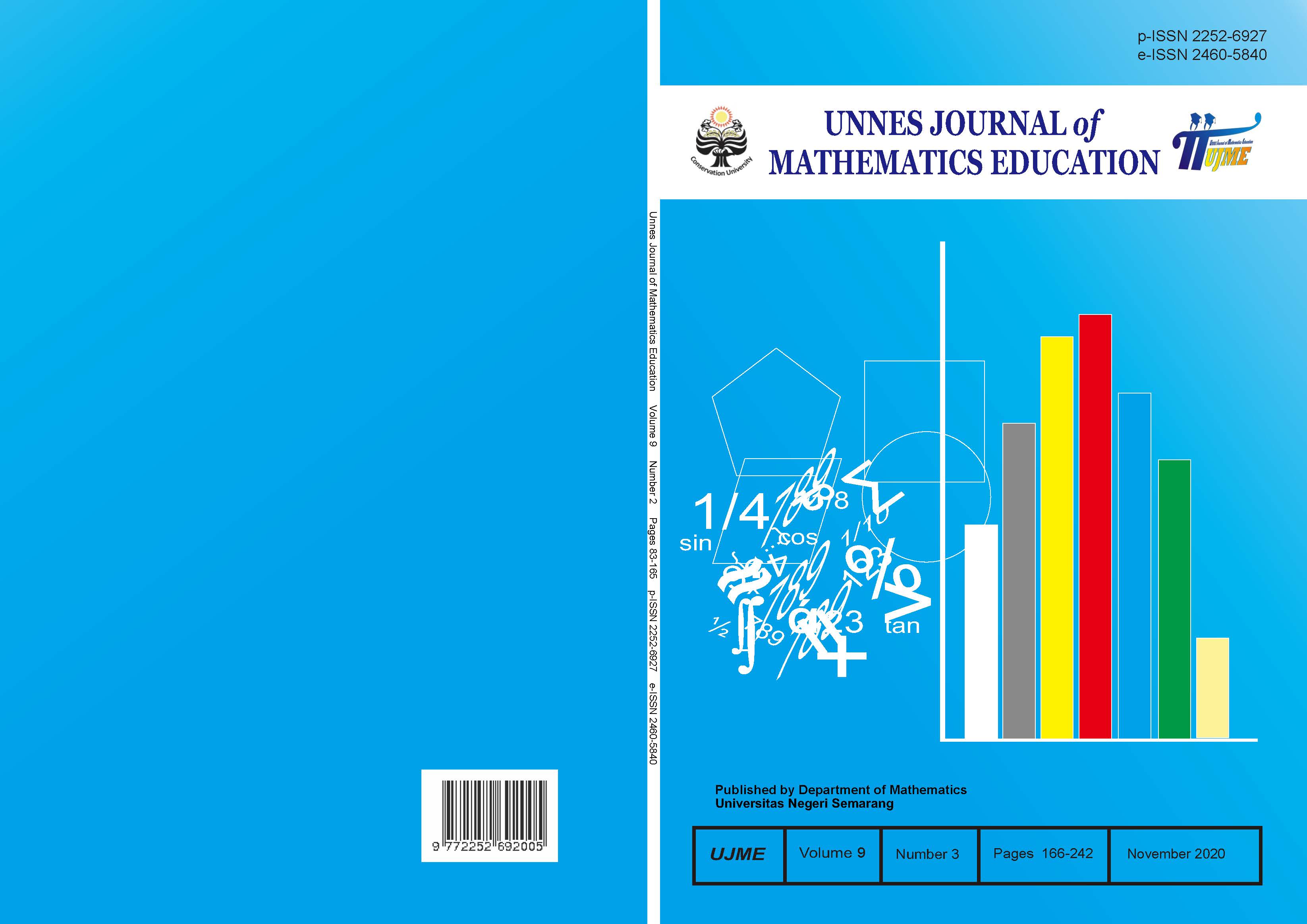Students' mathematical connection ability reviewed from learning style on Auditory, Intellectually, Repetition learning model
##plugins.themes.academic_pro.article.main##
Abstract
The aims of this study are to (1) comprehensively analyze the achievement of learning completeness of students' mathematical connection ability with the AIR learning model, (2) to find out the improvement in mathematical connection ability with the AIR learning model, (3) to comprehensively analyze the students’ mathematical connection ability with the AIR and DL learning model. , (4) to analyze the difference in the proportion of completeness on the students’ mathematical connection with the AIR and DL learning model, (5) to describe students’ mathematical connection ability on the AIR learning model based on learning style. This research used descriptive quantitative method and class 7 SMP Negeri 16 Semarang for the academic year 2019/2020 became the population of this research. The results showed that (1) the students’ mathematical connection ability on the AIR learning model achieved learning completeness, (2) There was an improvement in the mathematical connection ability of the class on the AIR learning model, (3) the students' mathematical connection ability on AIR learning was better than DL, (4) the proportion of completeness on the test results of students’ mathematical connection ability on the AIR learning was better than DL, (5) the mathematical connection ability reviewed from learning styles was (a) students with the visual learning style met all mathematical connection indicators (b) students with the auditory learning style met three mathematical connection indicators (c) students with the kinesthetic learning style met three mathematical connection indicators
##plugins.themes.academic_pro.article.details##
References
Bire, A.L., Geradus, U., & Bire, J. (2014). Pengaruh Gaya Belajar Visual, Auditorial, dan Kinestetik Terhadap Prestasi Belajar Siswa. Jurnal Kependidikan. 44(2), 168-174.
Creswell, J. W. 2014. Penelitian Kualitatif & Desain Riset. Yogyakarta: Pustaka Pelajar.
Creswell, J.W. (2014), Research Design: Pendekatan Kualitatif, Kuantitatif, dan Mixed. Yogyakarta: Penerbit Pustaka Pelajar.
Dave, M. (2002). The Accelerated Learning Handbook: Panduan Kreatif & Efektif Merancang Program Pendidikan dan Pelatihan. Bandung: Kaifa PT. Mizan Pustaka.
DePorter, B. & M. Hernacki. (2015). Quantum Learning: Membiasakan Belajar Nyaman dan Menyenangkan. Bandung: Kaifa.
Dewi, Nuriana Rachmani. 2013. Peningkatan Kemampuan Koneksi Matematis Mahasiswa Melalui Brain-Based Learning Berbantuan Web. Prosiding SNMPM Universitas Sebelas Maret 2013. Solo: Universitas Sebelas Maret.
Hasrul. 2009. Pemahaman Tentang Gaya Belajar. Jurnal MEDTEK, 1(2): 8 Tersedia di http://ftunm.net/medtek/Jurnal%20Medt ek%20Vo.%201_No.2_Oktober%202009/ Hasrul.pdf [diakses 22 Juni 2019].
Hasrul. 2009. Pemahaman Tentang Gaya Belajar. Jurnal MEDTEK, 1(2): 8.
Karniasih, Ida & M. Sinaga. 2014. Enhancing Mathematical Problem Solving and Mathematical Connection Through the Use of Dynamic Software Autograph in Cooperative Learning Think-Pair-Share. SAINSAB Journal.
Kemendikbud. 2013. Peraturan Menteri Pendidikan Nasional Republik Indonesia Nomor 81A Tahun 2013 Tentang Implementasi Kurikulum Pedoman Umum Pembelajaran. Jakarta: Kementerian Pendidikan dan Kebudayaan.
Kemendikbud. 2013. Peraturan Menteri Pendidikan Nasional Republik Indonesia Nomor 65 Tahun 2013 Tentang Standar Isi untuk Satuan Pendidikan Dasar dan Menengah. Jakarta: Kementerian Pendidikan dan Kebudayaan.
Kusumawati, H., Endah, D. & Singgih. A. P. (2018). Gaya Belajar Siswa Berprestasi pada Mata Pelajaran Matematika Kelas V SD Negeri 03 Cibelok Pemalang. Jurnal Pesoda Dasar, 6(2), 1-10.
Latifah, N. U. & Agoestanto, A. (2015). Keefektifan Model Pembelajaran AIR dengan Pendekatan RME terhadap Kemampuan Komunikasi Matematik Materi Geometri Kelas VII. Unnes Journal of Mathematics Educations, 4(1).
Moussa, N. 2014. The Importance of Learning Styles in Education. Institute for Learning Styles Journal. Vol.1 :19.
National Council of Teachers of Mathematics. (2000). Principles Standards and for School Mathematics. Reston, VA: NCTM.
NCTM. 1989. Curriculum and Evaluation Standards for Scholl Mathematics Reston. VA: NCTM.
Sugiyono. 2016. Metode Penilitian Pendidikan. Bandung: Alfabeta.
